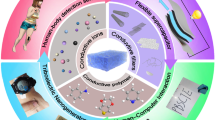Abstract
Hybrid organic/inorganic nanostructures are engineered to function as two terminal devices with enhanced functionality. The devices are the building blocks for designing hybrid organic/inorganic circuits in the nanoscale. In our work, we have demonstrated the sensing capabilities of polymer nanocomposite thin films for designing nanoweb devices towards detection of biomolecules. Biomolecules with surface charge such as troponin-T were detected on this device by interfacing them with the polymer/metal composites. The change in electrical properties due to modulation in charge transport at the crossbar junction was identified as the measured electrical signal for designing switch based sensors. Nanotextured surface offers strong charge carrier transport and hence enhances the strength of the detected signal. The antibodyantigen interactions at the junction effectively modulate the charge transfer kinetics and modify the junction characteristics due to the surface potential associated with the organic molecules. The net change in surface charge can be measured either as changes in the diode current in the two terminal configuration or as changes in the source- drain current in the three terminal configuration. Detection sensitivity in the order of pg/mL was targeted by measuring the voltammetric current response (in microamperes).
Similar content being viewed by others
References
Cheung W., {etet al.}, Fabrication of high performance conducting polymer nanocomposites for biosensors and flexible electronics: summary of the multiple roles of DNA dispersed and functionalized single walled carbon nanotubes. Journal of Materials Chemistry, 2009. 19(36): p. 6465–6480.
Dalvi-Malhotra J., Development of polymer nanocomposites with high refractive indices for LED and advanced optoelectronic applications. Abstracts of Papers of the American Chemical Society, 2012. 243.
Mazeiko V., {etet al.}, Gold nanoparticle and conducting polymer-polyaniline-based nanocomposites for glucose biosensor design. Sensors and Actuators B-Chemical, 2013. 189: p. 187–193.
de Souza Ribeiro F.A., {etet al.}, Development of a square wave voltammetric method for dopamine determination using a biosensor based on multiwall carbon nanotubes paste and crude extract of Cucurbita pepo L. Sensors and Actuators B: Chemical. 185(0): p. 743–754.
Ramanaviciene A. and A. Ramanavicius, Towards the hybrid biosensors based on biocompatible conducting polymers. Uv Solid-State Light Emitters and Detectors, 2004. 144: p. 287–296.
Arshak K., {etet al.}, Conducting Polymers and Their Applications to Biosensors: Emphasizing on Foodborne Pathogen Detection. Sensors Journal, IEEE, 2009. 9(12): p. 1942–1951.
Usha A., B. Ramachandra, and M.S. Dharmaprakash, Optimized design of bio-sensor using conducting polymers and nanocomposites. International Journal of Engineering Science and Technology, 2011. 3(4).
Godovsky D.Y., Device applications of polymer-nanocomposites. Biopolymers/Pva Hydrogels/Anionic Polymerisation Nanocomposites, 2000. 153: p. 163–205.
Santhanam K.S.V., Conducting polymers for biosensors: Rationale based on models. Pure and Applied Chemistry, 1998. 70(6): p. 1259–1262.
Chen A.C. and B. Shah, Electrochemical sensing and biosensing based on square wave voltammetry. Analytical Methods, 2013. 5(9): p. 2158–2173.
Hall D.B., P. Underhill, and J.M. Torkelson, Spin coating of thin and ultrathin polymer films. Plymer Engineering an dscience, 1999. 38: p. 2039–2045.
Author information
Authors and Affiliations
Rights and permissions
About this article
Cite this article
Shanmugam, N.R., Rana, M.N. & Prasad, S. Design of nano webs for hybrid sensor devices. MRS Online Proceedings Library 1690, 8–13 (2014). https://doi.org/10.1557/opl.2014.817
Published:
Issue Date:
DOI: https://doi.org/10.1557/opl.2014.817




